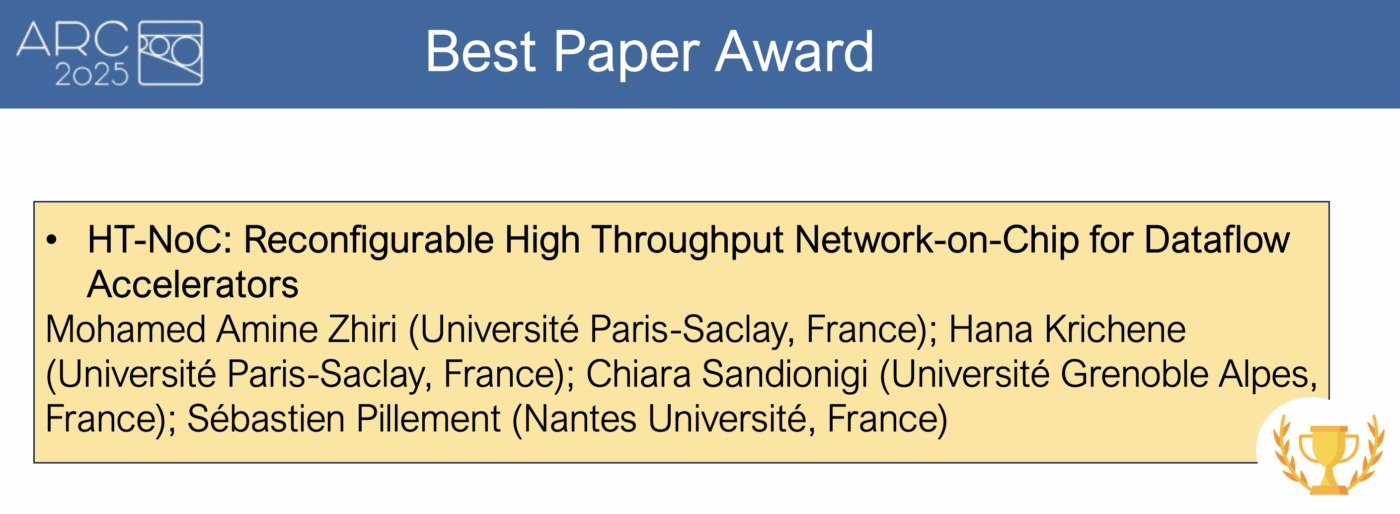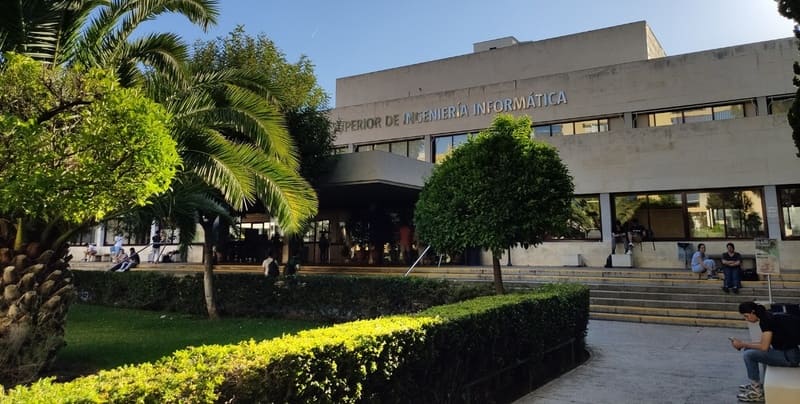The 21st International Symposium on Applied Reconfigurable Computing ARC 2025
The requirements of electronic systems, in terms of functionality, performance, costs, consumption, and reliability, make new processing paradigms, architectures,and technologies necessary. Reconfigurable computing is crucial in several application domains such as artificial intelligence, cybersecurity, communication, and automotive, among many others. This symposium aims to explore and advance applications leveraging cutting-edge reconfigurable computing technologies.
Now in its twenty-first edition, the symposium will be held in the beautiful city of Seville, the capital of Andalusia in southern Spain. Beyond its academic significance, this event provides a unique platform for researchers and professionals to network, collaborate, and share the most advanced topics and aspects of applied reconfigurable computing. This edition is being organized by the Institute of Microelectronics of Seville, with the support of the Spanish National Research Council (CSIC) and the University of Seville.
The ARC 2025 proceedings will be published as a volume in Springer’s Lecture Notes in Computer Science (LNCS) series and will also be available through the SpringerLink online service. The authors of the best ARC2025 accepted papers will be invited to submit extended versions of their papers to a special section of ACM Transactions on Reconfigurable Technology and Systems (TRETS) dedicated to ARC2025.

CONFERENCE PROCEEDINGS
Applied Reconfigurable Computing
Architectures, Tools, and Applications
21st International Symposium, ARC 2025, Seville, Spain, April 9–11, 2025, Proceedings

FINALISTS AND BEST PAPER ARC 2025
Finalists
•Out-of-the-Box Performance of FPGAs for ML Workloads using Vitis AI
Deepak Kumar Athur (Arizona State University, USA); Rutuparn Pawar (University of Texas at Austin, USA); Aman Arora (Arizona State University, USA)
•An MLIR-based Compilation Framework for CGRA Application Deployment
Yuxuan Wang (EPFL, Switzerland); Cristian Tirelli (Università della Svizzera italiana, Switzerland); Lara Orlandic (EPFL, Switzerland); Juan Sapriza (EPFL, Switzerland); Rubén Rodríguez Álvarez (EPFL, Switzerland); Giovanni Ansaloni (EPFL, Switzerland); Laura Pozzi (Università della Svizzera italiana, Switzerland); David Atienza (EPFL, Switzerland)

COMMITTEE
General Chair
- Piedad Brox Jiménez, Instituto de Microelectrónica de Sevilla (IMSE-CNM), CSIC-US, Spain
- Ángel Barriga Barros, Instituto de Microelectrónica de Sevilla (IMSE-CNM), US-CSIC, Spain
Program Chairs
- Roberto Giorgi, University of Siena, Italy
- Mirjana Stojilović, EPFL, Switzerland
Publicity Chairs
- Martin Margala, University of Louisiana at Lafayette, USA
- Kevin Martin, Université de Bretagne Sud, France
- Madhura Purnaprajna, PES University, India
Local Chairs
- Macarena C. Martínez-Rodríguez,Instituto de Microelectrónica de Sevilla (IMSE-CNM), CSIC-US, Spain
- David Martín Sánchez, Instituto de Microelectrónica de Sevilla (IMSE-CNM), CSIC-US, Spain
Proceedings Chair
- Dirk Stroobandt, Ghent University, Belgium
Special Session and Issue (20 years of ARC) Chairs
- João MP Cardoso, University of Porto, Portugal
- Walid Najjar, University of California Riverside, USA
Journal Special Issue
- João MP Cardoso, University of Porto, Portugal
Finance Chair
- Víctor García Flores, Instituto de Microelectrónica de Sevilla (IMSE-CNM), CSIC-US, Spain
Workshops and Tutorials Chair
- Eros Camacho-Ruiz, Instituto de Microelectrónica de Sevilla (IMSE-CNM), CSIC-US, Spain
- José Miguel Mora Gutiérrez, Instituto de Microelectrónica de Sevilla (IMSE-CNM), CSIC-US, Spain
Web Chair
- Macarena C. Martínez-Rodríguez,Instituto de Microelectrónica de Sevilla (IMSE-CNM), CSIC-US, Spain
Student Volunteers
- Pau Ortega Castro, Instituto de Microelectrónica de Sevilla (IMSE-CNM), CSIC-US, Spain
- Pablo Navarro Torrero, Instituto de Microelectrónica de Sevilla (IMSE-CNM), CSIC-US, Spain
- Apurba Karmakar, Instituto de Microelectrónica de Sevilla (IMSE-CNM), CSIC-US, Spain
Technical Program Committee
- Michael Adler, Altera
- Hideharu Amano, Keio University
- Caaliph Andriamisaina, Commissariat à l’Énergie Atomique et aux Énergies Alternatives
- Nikolaos Bellas, University of Thessaly, Greece
- Mladen Berekovic, ITI Uni Luebec
- Joao Bispo, University of Porto/INESC_TEC
- Vanderlei Bonato, Institute of Mathematical and Computer Sciences
- Alejandro Cabrera Aldaya, Tampere University
- João Cardoso, University of Porto
- Luigi Carro, Instituto de Informatica / UFRGS
- Ray Cheung, City University of Hong Kong
- Daniel Chillet, University of Rennes – IRISA/ENSSAT
- Darshan Gandhi, The University of Texas at Austin
- Pedro Diniz, INESC-ID
- Ricardo Ferreira, Universidade Federal de Vicosa
- Roberto Giorgi, University of Siena
- Diana Goehringer, TU Dresden
- Frank Hannig, Friedrich-Alexander-Universität Erlangen-Nürnberg
- Christian Hochberger, TU Darmstadt
- Michael Huebner, Brandenburg University of Technology Cottbus
- Krzysztof Kepa, GE Global Research
- Georgios Keramidas, Aristotle University of Thessaloniki/Think Silicon S.A.
- Paris Kitsos, University of Peloponnese
- Andreas Koch, TU Darmstadt
- Tomasz Kryjak, AGH University of Science and Technology
- Francesco Leporati, University of Pavia
- Konstantinos Masselos, University of the Peloponnese
- Cathal McCabe, AMD
- Antonio Miele, Politecnico di Milano
- Takefumi Miyoshi, e-trees.Japan, Inc.
- Horacio Neto, INESC-ID/IST/ULisboa
- Nuno Paulino, INESC TEC
- Marco Platzner, University of Paderborn
- Dionisios Pnevmatikatos, National Technical University of Athens
- Madhura Purnaprajna, PES University, Bangalore
- Francesco Regazzoni, University of Amsterdam and Università della Svizzera italiana
- Martin Rönnbäck, Cobham gaisler
- Kentaro Sano, Riken R-CCS
- Marco Domenico Santambrogio, Politecnico di Milano
- Antonio Carlos Schneider Beck Filho, Universidade Federal do Rio Grande do Sul
- Dimitrios Soudris, National Technical University of Athens
- Ioannis Sourdis, Chalmers University of Technology
- Srdjan Stankovic, University of Montenegro, Faculty of Electrical Engineering
- Mirjana Stojilović, EPFL
- Theocharis Theocharides, University of Cyprus
- George Theodoridis, University of Patras
- Markus Weinhardt, Osnabrueck University of Applied Sciences, Fak. IuI
VENUE

The symposium will take place at the Computing Engineering School (ETSII) of the University of Seville. University Campus placed at Reina Mercedes Avenue.
Conference Management
ISBILYA Travel
arc2025@isbilyatravel.com
A selection of hotels that are relatively close to the meeting venue offered special prices for the meeting:
HOW TO REACH THE COMPUTING
ENGINEERING SCHOOL
- The closest airport to the conference
venue is the Seville-San Pablo
International Airport. - From the airport to the Computing
Engineering School is about 18 km.
The taxi ride is about 30 €.
- High Speed AVE trains connect Seville
with Madrid and Málaga in 2h30m and
1h50m respectively. - From the Seville-Santa Justa Train
Station to the Computing Engineering
School is about 5 km. The taxi ride is
about 15 €.
ABOUT THE CITY OF SEVILLE

SPECIAL THANKS
Conference Sponsors


